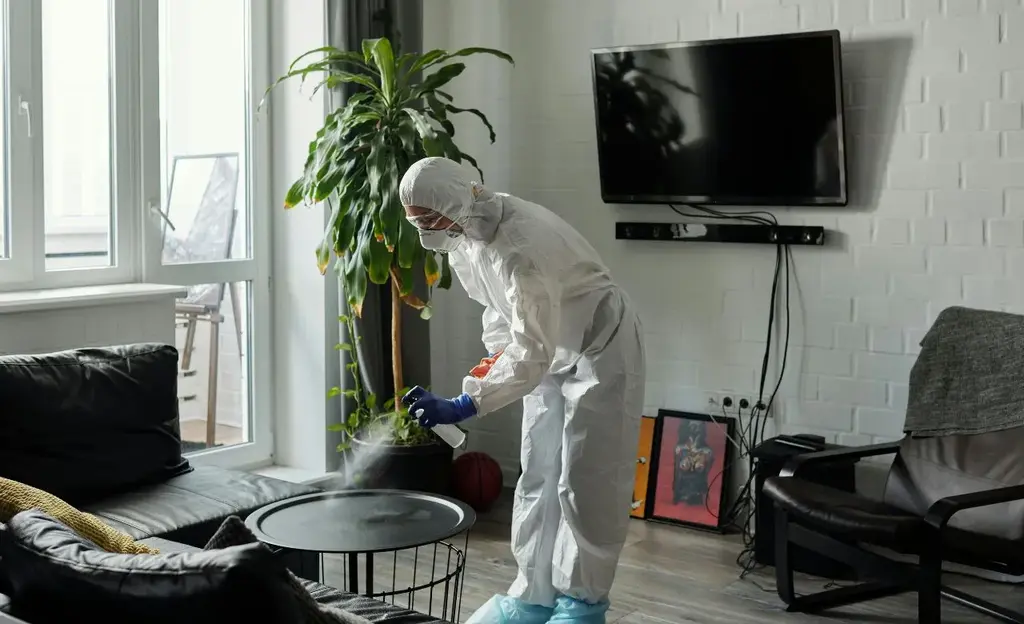Welcome to our blog. we’re all about making your comfy couch look and feel fantastic without any fuss! Today, we’re tackling How To Clean Fabric Sofa At Home—no need for fancy stuff – just some easy steps and everyday items. Get ready to say bye-bye to stains and hello to a sofa that’s as cozy as it is clean! Let’s dive into the simple world of sofa cleaning together!
How To Deep Clean Fabric Sofa And Microfiber Couches
Discover the secrets to maintaining the beauty of your fabric or microfiber sofa with these straightforward steps. In this guide, we’ll walk you through the deep cleaning process, ensuring your sofa not only looks new but stays comfortable too. Let’s dive into hassle-free techniques that will keep your favourite place in the house clean and inviting.
Steps For How To Clean Fabric Sofa At Home
- Prepare The Couch
- Vacuum the upholstery
- Test a hidden spot
- Clean dingy arms and headrests
- Sanitize the couch
- Cleaning Dingy Areas
- Additional Tips
Step-01: Prepare The Couch
Use a handheld garment steamer or bursts from your steam iron to kill surface dust mites and refresh the fabric. Hold the steamer a few inches away from the fabric and move sweepingly.

Step-02: Vacuum the upholstery
Use the upholstery attachment on your vacuum cleaner to remove loose dirt and debris. Pay close attention to corners and seams, and consider using a vacuum with a HEPA filter to effectively remove allergens.
Read More Vacuum Cleaner Review
Step-03:Test a hidden spot
Before diving for deep cleaning, it’s important to test a hidden spot on your couch to ensure that the cleaning solution doesn’t cause any damage or discolouration. Choose a spot that is not easily visible, such as the back or bottom of the couch.
Step-04:Spot Testing
Before cleaning the spot, test a hidden spot on your couch to ensure the cleaning solution won’t cause damage or discolouration. Choose an inconspicuous area, such as the back or bottom, for this crucial step.
Step-05: Spot-clean stains
If you notice any stains on your couch, it’s important to spot-clean them before proceeding with the deep cleaning process. Use a fabric cleaner or a mixture of warm water and mild detergent to dab at the stain gently. Avoid rubbing, as this can spread the stain further.
Step-06: Clean dingy arms and headrests
Over time, the arms and headrests of your couch can become dirty and dingy. To clean these areas, mix a small amount of mild detergent with warm water and use a soft cloth or sponge to gently clean the fabric. Rinse with clean water and allow to air dry.
Step-07:Sanitize the couch
To ensure that your couch is thoroughly clean and sanitized, use a fabric disinfectant spray or a mixture of white vinegar and water to mist the entire surface. Allow the couch to air dry completely before using it.
Remember, it’s important to check the manufacturer’s instructions for your specific couch before deep cleaning, as some fabrics may require special care. By following these steps, you can keep your fabric or microfiber couch looking fresh and clean for years.
How To Clean A Leather Couch
Learn how to easily clean your leather sofa at home without the need for fancy equipment or expensive cleaning solutions. Using a simple mixture of water and vinegar, you can easily wipe away dirt and grime from your leather sofa with a clean cloth.
This quick and affordable cleaning method is the perfect way to keep your sofa looking fresh and new. Leather sofas add an element of elegance and sophistication to any living space, but proper care is crucial to maintaining their original appearance.
Follow these tips to effectively clean a leather sofa at home:
- Use a soft cloth or microfiber cloth to remove any loose dirt or debris from the surface of the leather couch. Gently dust off the couch to avoid scratching the leather.
- Create a cleaning solution by mixing equal parts of water and mild soap or liquid dish soap. Dip a clean cloth into the solution and wring out excess moisture.
- Wipe down the entire leather couch using the damp cloth. Be sure to clean all surfaces, including the seat cushions, arms, and backrests.
- For tougher stains or dirt buildup, you can use a leather cleaner specifically designed for leather furniture. Follow the instructions on the cleaner and use a clean cloth to apply it evenly across the affected areas.
- After cleaning, use a separate clean, dry cloth to wipe away any excess moisture. This step is crucial to prevent water spots or damage to the leather.
Follow these tips to effectively Maintain the leather sofa at home:
- Avoid using harsh chemicals, bleach, or abrasive cleaners on your leather couch as they can strip away the natural oils and damage the leather.
- Regularly dust and clean your leather couch to prevent dirt and grime from settling into the leather pores. This will help maintain its appearance and extend its lifespan.
- Apply a leather conditioner or protectant after cleaning to keep your leather couch looking shiny and fresh. These products help moisturize the leather and protect it from drying out or cracking.
- Keep your leather couch away from direct sunlight and heat sources, as these can cause the leather to fade or become brittle over time.
If you have any doubts about cleaning your leather couch or dealing with specific stains, it’s always best to consult with a professional leather cleaning service.
By following these simple steps, you can effectively clean your leather couch at home and keep it looking beautiful for years to come.
How To Get Smells Out Of Couch Fabric:
To remove smells from couch fabric and clean your sofa at home, start by vacuuming the upholstery to remove any surface dust. Then, use a handheld garment steamer or bursts of steam from an iron to kill dust mites. Spot-clean any stains and sanitize the couch using a solution of equal parts water and white vinegar. Air-dry the sofa and vacuum again to restore the fabric’s texture. Avoid using too much water to prevent damage. Getting rid of unpleasant odors from your couch fabric can make a big difference in the overall freshness of your living space.
Here are some effective methods to eliminate smells from your sofa:
Baking soda: Baking soda: Sprinkle baking soda liberally on the fabric, and leave it for at least 15 minutes or overnight if possible. Dust off the baking soda afterward to remove any lingering odors. This natural, cost-effective method is great for getting rid of mild odors and requires minimal effort.
White vinegar solution: Mix equal parts of white vinegar and water in a spray bottle. Lightly spray the solution onto the fabric and let it air dry. The vinegar will neutralize any smells and freshen up the fabric. This method is effective, affordable, and requires minimal resources.
Fresh air: If the weather permits, open your windows and let fresh air circulate in the room. This natural method can go a long way in eliminating odors from your couch fabric. It’s a simple and cost-free option that promotes ventilation.
Fabric refreshers: Use a commercially available fabric refresher spray designed to eliminate odors. Follow the instructions on the product label to effectively deodorize your sofa. This option is convenient and may offer a quick solution for busy individuals.
Steam cleaning: Steam cleaning not only removes dirt and stains but also helps eliminate odors. Use a steam cleaner on your couch fabric according to the manufacturer’s instructions to freshen it up. While this method may require a steam cleaner, it’s a thorough and effective solution for deep cleaning.
Baking soda and essential oils: Combine baking soda with a few drops of your favorite essential oil. Mix well and sprinkle it on the fabric, allowing it to sit before vacuuming. Your sofa will not only smell fresh but also have a pleasant fragrance. This DIY option adds a personalized touch with the choice of essential oils.
Sunlight: If your couch cushions are removable, take them outside and let them air out in the sunlight. Sunlight is a natural deodorizer and can help eliminate odors from the fabric. This method is ideal for those looking for a simple and energy-efficient solution.
Charcoal odor absorbers: Place charcoal odor absorbers, like activated charcoal bags or briquettes, near your sofa. Charcoal is known for its ability to absorb and eliminate odors. This option, though it may involve a small cost, is a passive and long-lasting solution.
Fabric deodorizing sprays: Use a fabric deodorizing spray specifically made for upholstery. These sprays are formulated to neutralize odors and leave a fresh scent on your couch fabric. While this option may incur a cost, it provides a targeted and convenient solution.
Regular maintenance: Prevention is key! Regularly vacuum your couch to remove any dirt, dust, and potential odor-causing particles. This will help keep your sofa smelling fresh for longer. Incorporating this routine into your cleaning schedule is a proactive approach to maintaining a pleasant environment.
Remember, it’s essential to read and follow the instructions on any cleaning products or methods you use to ensure the safety and longevity of your couch fabric.
More Couch Cleaning Tips:
Are you looking for more couch-cleaning tips? Learn how to clean your sofa at home without the need for a machine by steam cleaning the couch, vacuuming the upholstery, spot-cleaning stains, and sanitizing the entire couch. You can also try using a solution of equal parts water and white vinegar for a natural cleaning remedy.
Keeping your sofa clean and fresh is important for maintaining its appearance and prolonging its lifespan. Here are some additional tips to help you achieve professional-level results when cleaning your couch:
- Vacuum regularly: Use a handheld vacuum or an attachment to remove loose dirt, crumbs, and pet hair from your sofa. Pay special attention to the crevices and between the cushions.
- Spot clean stains: For small stains, mix a mild detergent with water and apply it to the stained area using a soft cloth or sponge. Gently blot the stain until it is lifted. Avoid rubbing, as this can spread the stain and damage the fabric.
- Check for colorfastness: Before using any cleaning solution on your sofa, test it on a small, inconspicuous area first. This will ensure that the solution doesn’t cause any discoloration or damage to the fabric.
- Use a steam cleaner: If your sofa is heavily soiled or has deep-set stains, consider using a steam cleaner. This powerful tool can help remove dirt and grime from the upholstery, leaving it refreshed and revitalized. Follow the manufacturer’s instructions for safe and effective use.
- Freshen up with baking soda: Sprinkle some baking soda over your sofa and let it sit for a few hours before vacuuming it off. Baking soda helps remove odors and refreshes the fabric.
- Protect with slipcovers or throws: To prevent stains and spills from reaching your sofa’s upholstery, consider using slipcovers or throws that can easily be removed and washed. This will help keep your sofa looking clean and well-maintained.
- Maintain proper ventilation: Good air circulation is essential for keeping your sofa fresh and free from unpleasant odors. If possible, open windows or use fans to promote airflow in the room where your sofa is located.
- Avoid direct sunlight: Prolonged exposure to sunlight can cause fading and damage to your sofa’s fabric. Place your sofa away from direct sunlight or use curtains or blinds to protect it.
- Professional cleaning: If your sofa is heavily soiled or has stubborn stains, it may be best to hire a professional upholstery cleaner. They have the expertise and specialized equipment to deep clean and revitalize your sofa.
- Regular maintenance: Lastly, don’t forget to regularly fluff and rotate the cushions of your sofa to distribute the wear and maintain its shape. This will help prolong the life of your sofa and keep it looking its best.
By following these additional couch cleaning tips, you can ensure that your sofa remains clean, fresh, and in top condition for years to come. Happy cleaning!

Credit: homepluscleaning.com
Frequently Asked Questions On How To Clean Sofa At Home
What Is The Best Way To Clean A Fabric Sofa?
To clean a fabric sofa, follow these steps: 1. Steam the couch to kill surface dust mites. 2. Vacuum the upholstery to remove loose dirt. 3. Test a hidden spot before applying any cleaner. 4. Spot clean stains with a solution of water and white vinegar. 5. Wipe down the entire couch with a clean, damp cloth. Remember to air dry the sofa and restore its texture with a final vacuuming.
How Do You Deep Clean A Couch By Yourself?
To deep clean a couch by yourself, follow these steps: 1. Steam the couch to kill dust mites. 2. Vacuum the upholstery. 3. Test a hidden spot with a cleaning solution. 4. Spot clean stains. 5. Clean arms and headrests. 6. Sanitize the couch. Alternatively, mix equal parts water and white vinegar in a spray bottle, test on a small area, then spray and wipe down the entire couch.
What Is The Best Home Remedy To Clean Couch?
Mix equal parts water and white vinegar in a spray bottle. Test on a small area first, then spray the entire couch and wipe with a clean, damp cloth.
How Do You Deep Clean A Couch Without A Machine?
To deep clean a couch without a machine, mix equal parts water and white vinegar in a spray bottle. Test on a small area first. If it’s safe, spray the entire couch and wipe with a clean, damp cloth.
Conclusion
Keeping your sofa clean and fresh is essential for a comfortable and inviting living space. By following the tips and techniques outlined in this blog post, you can easily clean your sofa at home without any hassle. From regular vacuuming to spot cleaning stains and using natural remedies like vinegar and water solution, there are various methods to choose from based on your sofa’s fabric type.
With these simple steps, you can keep your sofa looking new and extend its lifespan. So, say goodbye to dirt and stains and enjoy a clean and cozy sofa in your home.





